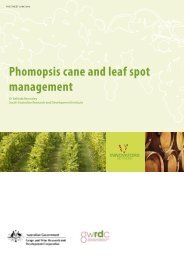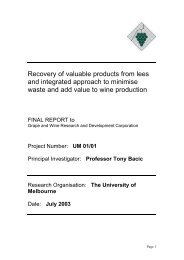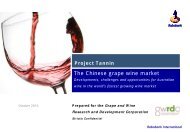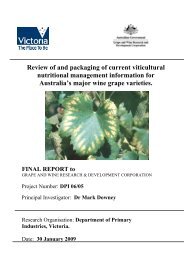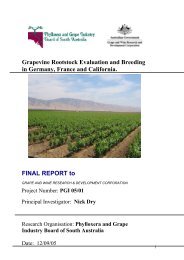Identification of the major drivers of 'phenolic' taste in ... - GWRDC
Identification of the major drivers of 'phenolic' taste in ... - GWRDC
Identification of the major drivers of 'phenolic' taste in ... - GWRDC
You also want an ePaper? Increase the reach of your titles
YUMPU automatically turns print PDFs into web optimized ePapers that Google loves.
AWRI: <strong>Identification</strong> Of The Major Drivers Of ‘Phenolic’ Taste In White W<strong>in</strong>es<br />
8.5.3 Phenolic Measures (HPLC) – 2010 w<strong>in</strong>es<br />
Over 50 phenolic compounds were detected, putatively identified and quantified <strong>in</strong> this study and <strong>the</strong>y<br />
can be classified <strong>in</strong> several ways: <strong>in</strong> a broad, polyphenolic class (hydroxybenzoic acids, hydroxyc<strong>in</strong>namic<br />
acids, flavan-3-ols, flavonols, GRP-conjugates etc.), or with <strong>the</strong>se subdivided <strong>in</strong>to ethyl esters (EE) or<br />
glycoconjugates. A list <strong>of</strong> <strong>the</strong> identified compounds, <strong>the</strong>ir classifications groups and <strong>the</strong> equivalent units<br />
used for quantification is given <strong>in</strong> Appendix B, Table B-7. These data are presented alongside average<br />
literature values collected by <strong>the</strong> INRA Montpellier as part <strong>of</strong> <strong>the</strong> Phenols Explorer project (Neveu et al.<br />
2010). The total phenolics were determ<strong>in</strong>ed by summ<strong>in</strong>g unidentified early elut<strong>in</strong>g compounds (expressed<br />
as mg/L GAE) and all <strong>the</strong> named compounds. Mean values are shown for each variety <strong>in</strong> Figure 8-9 and<br />
sorted by treatment <strong>of</strong> all three varieties <strong>in</strong> Figure 8-10.<br />
The concentrations <strong>of</strong> <strong>the</strong> broad polyphenolic classes averaged across all varieties and treatments are<br />
given <strong>in</strong> Figure 8-11, by variety (Figure 8-12), and by w<strong>in</strong>emak<strong>in</strong>g treatment (Figure 8-13). Some classes<br />
such as <strong>the</strong> flavonols, flavanones, phenols, and c<strong>in</strong>namic acids and GRP conjugates vary widely between<br />
varieties. Riesl<strong>in</strong>g tends to show higher c<strong>in</strong>namic acids, flavanones and flavanol-type compounds, while<br />
Viognier has higher GRP analogues and flavonols (Figure 8-12). The w<strong>in</strong>es from macerated juices had<br />
<strong>the</strong> highest concentrations <strong>in</strong> flavonols, flavanonols and c<strong>in</strong>namic acids (Figure 8-13) and would suggest<br />
that <strong>the</strong>se compounds are located <strong>in</strong> sk<strong>in</strong>s and <strong>in</strong>crease <strong>in</strong> concentrations dur<strong>in</strong>g cold soak<strong>in</strong>g. However,<br />
benzoic acids, o<strong>the</strong>r phenols and flavan-3-ols show fairly constant concentrations across <strong>the</strong> different<br />
treatments and potentially com<strong>in</strong>g only from grape flesh are not <strong>in</strong>fluenced by maceration.Figure 8-14<br />
shows a f<strong>in</strong>er sub-division <strong>of</strong> some <strong>of</strong> <strong>the</strong> broad classes <strong>in</strong>to ethyl esters (EE) and glycoconjugates<br />
averaged across all varieties and treatments. The variations described earlier can be more precisely<br />
ascribed to free hydroxyc<strong>in</strong>namoyl tartaric acids (caftaric acid, coutaric acid and fertaric acid) and<br />
flavonol glycoconjugates (ma<strong>in</strong>ly quercet<strong>in</strong>-3-O-glucuronide).<br />
78




